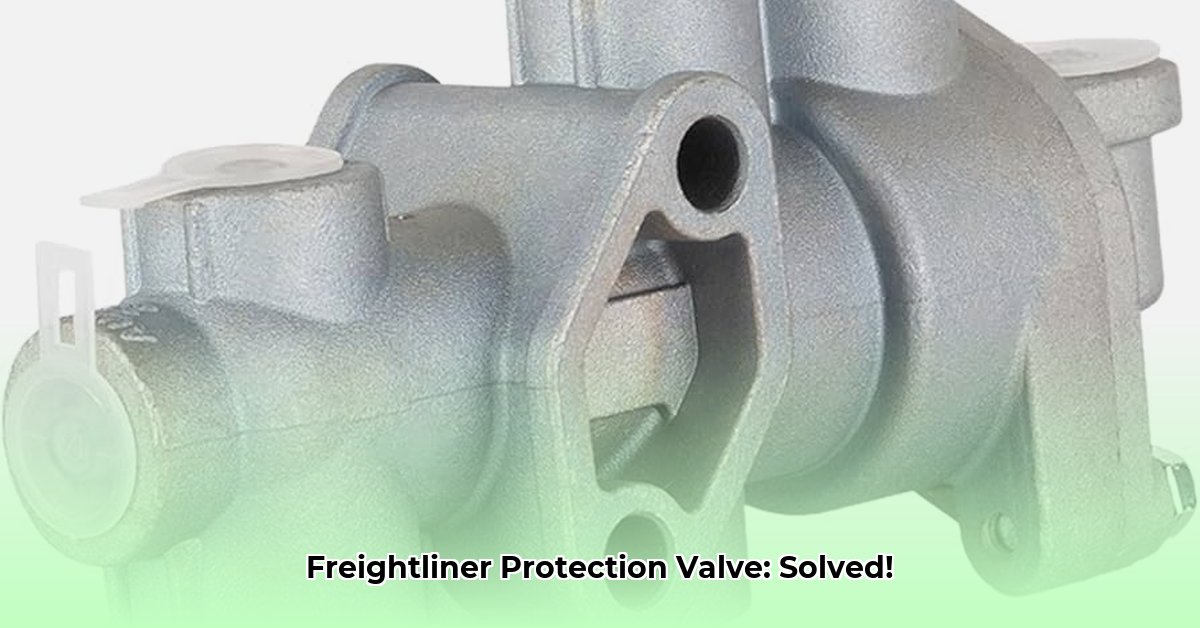
Keeping your heavy-duty truck safe on the road involves understanding its critical components. This guide focuses on the Freightliner tractor protection valve (TPV), specifically the TP-5 (part number BW800588), a crucial safety feature in your air braking system. We'll explore its function, maintenance, troubleshooting, and compare it to aftermarket alternatives, helping you make informed decisions for optimal fleet safety and regulatory compliance. For more detailed testing procedures, see our guide on TPV testing.
How a Tractor Protection Valve Works: Ensuring Air Brake System Integrity
Your truck's air brakes rely on consistent air pressure for safe operation. The TPV acts as a safety net, preventing catastrophic brake failure in case of sudden pressure loss. This could be triggered by an unexpected trailer disconnection, a major air leak, or other system malfunctions. The TPV's core function is to maintain sufficient air pressure in the tractor's braking system, preventing a complete loss of braking capability. When a significant pressure drop is detected, the TPV automatically shuts off, preserving the remaining air pressure for braking.
Freightliner TP-5 (BW800588): Specifications and Key Features
The Freightliner TP-5 (BW800588) is a robust TPV designed to withstand the harsh conditions of heavy-duty trucking. Constructed from high-grade materials (typically high-strength aluminum alloy), it's engineered for reliable performance under various loads and terrains. Its consistent operating pressure ensures dependable function, while its design ensures compliance with Department of Transportation (DOT) regulations. Key specifications include:
| Specification | Typical Value | Notes |
|---|---|---|
| Part Number | BW800588 | Freightliner OEM part number |
| Operating Pressure | 100-120 PSI (approximate) | May vary slightly depending on model/version |
| Material | High-strength aluminum alloy (typical) | Material composition can vary slightly |
| Temperature Range | -40°F to +185°F (approximate) | Consult your specific TPV documentation |
OEM vs. Aftermarket TPVs: A Comparative Analysis
Choosing between an OEM Freightliner TP-5 and an aftermarket alternative involves a cost-benefit analysis. OEM parts guarantee a perfect fit and adhere to stringent quality standards, offering superior reliability and a comprehensive warranty. However, they typically command a higher price. Aftermarket TPVs often offer lower upfront costs but may compromise on reliability, warranty coverage, and DOT compliance. A critical question to ask yourself is: Is the potential cost savings worth the risk of a compromised safety system? A failure could lead to costly repairs, accidents, and legal ramifications.
| Feature | OEM (Freightliner TP-5) | Aftermarket |
|---|---|---|
| Cost | Higher | Lower |
| Reliability | High; rigorously tested and proven | Variable; depends on manufacturer & quality |
| Warranty | Comprehensive manufacturer warranty | Varies greatly; may be minimal or nonexistent |
| Compliance | Guaranteed DOT compliance | Requires verification of compliance |
Installation and Maintenance: Ensuring Optimal TPV Performance
Proper installation is crucial for safety and efficiency. Always follow the manufacturer's instructions and, if unsure, consult a qualified mechanic. Regular inspections are equally critical. Visual checks for wear, corrosion, or leaks should be part of routine maintenance, and replacements should be made based on recommended mileage intervals or upon detecting any issues.
Installation Steps:
- Disconnection: Safely disconnect air lines from the old TPV, noting the connection points.
- Mounting: Securely mount the new TPV in its designated location. Verify proper alignment and secure fastening.
- Reconnection: Carefully reconnect air lines, ensuring no kinks or damage.
- Leak Test: Conduct a thorough leak test using soapy water. Bubbles indicate the need for tightening or replacement of faulty connections.
Troubleshooting Common Issues: Addressing TPV Malfunctions
TPV problems can manifest as reduced braking power or unexpected valve activation. A methodical approach to diagnosis is essential:
- Air Leak Check: Carefully inspect the entire air braking system for leaks using soapy water.
- TPV Inspection: Examine the valve for damage, wear, or corrosion.
- Pressure Check: Verify correct air pressure throughout the braking system.
Regulatory Compliance: Meeting DOT Requirements
Compliance with all applicable DOT regulations is non-negotiable. Failure to comply can result in significant fines, downtime, and potential legal action. Ensure your TPV meets all current safety standards.
Conclusion: Prioritizing Safety and Operational Efficiency
The Freightliner TP-5 (BW800588) and other TPVs are vital for maintaining safe and efficient operations. While aftermarket options may seem attractive due to lower cost, the risks to safety and legal compliance must be thoroughly weighed. Regular inspections, proper maintenance, and adherence to DOT regulations are paramount in preventing costly breakdowns and, more importantly, accidents. Always prioritize safety when selecting and maintaining your TPV.